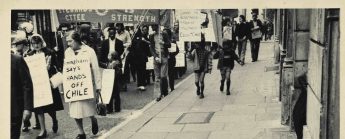With the general election now just days away – and the polls still so tight – attention is inevitably beginning to turn to those sections of the electorate who might have a decisive say in the outcome.
Among the most significant of these groups are BAME and immigrant voters. Research from both Operation Black Vote and the Migrants’ Rights Network has emphasised the pivotal role these voters might play on 7 May. Yet the recognition of the political significance of these electorates is far from new. Political parties have been concerned about their electoral behaviour – and actively pursuing their votes – for at least forty years.
Perhaps the first party to take these electorates seriously was the Conservatives, whose efforts to win the support of BAME voters were catalysed by the inquest into the twin election defeats of 1974. Analysis published in the autumn of the following year purported to show that the Conservatives’ poor performance in ‘ethnic marginals’ – seats in which the majority of the successful candidate was smaller than the BAME population of the constituency – had ultimately been responsible for both Labour victories. Had the party possessed a greater appeal to BAME voters, the report implied, it might never have lost office.
While many Conservatives – and particularly the party’s Research Department – viewed this analysis with considerable scepticism. However, the party was already aware that its performance among BAME voters was a cause for concern, and the 1975 research mere reinforced the perception that something needed to be done. The party responded by launching two new societies intended to act as a ‘temporary bridge’ between the Conservatives and BAME communities: the Anglo Asian Conservative Society [AACS] and the (National) Anglo West Indian Conservative Society [NAWICS]. While the existence of these societies has today been largely forgotten, news of their launch in the spring of 1976 attracted considerable media attention, and prompted The Spectator to predict that Margaret Thatcher might appear on national television wearing ‘a peacock blue sari’.
Perhaps the most obvious function of the AACS and NAWICS was to provide support to canvassers and candidates in constituencies with substantial BAME electorates, which ranged advice on how candidates should conduct themselves in mosques to the production of election literature translated into Urdu or Gujarati. Translation, however, was an exercise fraught with difficulty, and in 1983 one leaflet had to be hastily withdrawn after it was discovered that the word ‘sliced’ had been mistranslated as ‘circumcised’. Subsequent advice on the subject of translation advised candidates that they should ‘not bother with Asian languages’.
The objectives of the societies, however, were as much social as political. Those charged with running the AACS and NAWICS recognised that many BAME voters were perturbed by the popular perception of the Conservative Party as ‘the identikit bastion of white society’ – not to mention the discrimination that some encountered at grassroots level – and that the party needed to break down these barriers if it was to win their support. Activists were encouraged to accept invitations to attend functions and temples and mosques, and particular attention was paid to how to develop contacts with women. Organising events around food and clothing were thought to be particularly likely to foster enduring contacts between different communities, and guidance circulated to branches of the AACS and NAWICS envisaged a future in which recipe swaps and sari parties were an everyday feature of constituency life.
These activities came to an abrupt halt in 1986 when the societies were dissolved amid fears that the AACS had been the subject of a takeover by pro-Khalistani activists. In 1985 the annual general meeting of the society had been interrupted by a group of several hundred Sikhs blockading the entrance to Conservative Central Office, all the while brandishing kirpans and shouting pro-Khalistan slogans. When similar scenes were repeated the following year the party felt it had no choice but to intervene, and within six months had wound-up both the AACS and NAWICS, replacing them with a new, invitation-only, organisation, the One Nation Forum.
Whether the closure of the societies represented a loss to the Conservative Party is debateable. There is little evidence that their activities had any real impact on the electoral behaviour of BAME voters, most of whom remained (and remain) Labour supporters. However, many of those involved in the societies felt that they had played an important role in providing a pathway into the Conservatives for black and Asian activists, and regretted that the party had not built on their success. The founder chairman of the AACS, Narindar Saroop, wrote in his autobiography that ‘[in] not exploiting to the full the potential of these two assets’ the Conservatives have suffered ‘a self-inflicted wound’. Come the morning of 8 May his party may well have cause to regret failing to heed his words.





